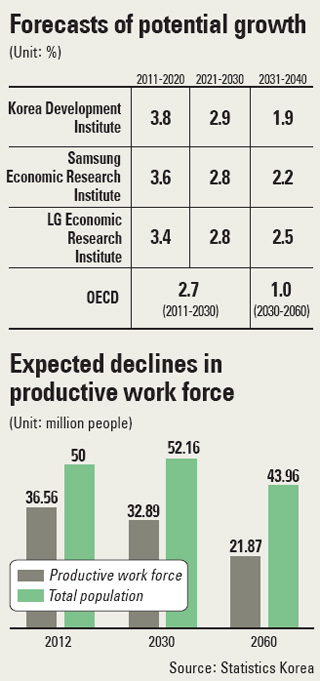Future shows aging, slowing growth

The report was the first of its kind produced by the Ministry of Strategy and Finance in cooperation with private think tanks Samsung Economic Research Institute and LG Economic Research Institute on long-term forecasts for the economy and policy measures needed to combat them.
It was written based on 30-year projections of economic developments, social changes and global trends.
It also includes some projections of how unification with North Korea could impact the economy.
The country’s annual potential growth rate will stay at 3.8 percent until 2020, but it could slow to 2.9 percent in the period between 2021-2030 and to 1.9 percent in the 2031-2040 period, according to the report.
A potential growth rate is the maximum possible rate at which an economy can expand without triggering inflation.
Such declines in potential growth are inevitable for an economy like Korea’s, which grew at a rapid clip in the past. After the country’s gross domestic product per capita reaches a certain level, it is usual to experience slowing in annual growth, it said.
Korea’s per capita GDP reached $23,697 this year, the 34th highest in the world, according to the International Monetary Fund.
However, Korea is less likely to fall into a long-term recession like Japan owing to manageable household debt levels and a more robust export-based economic structure, Choi Kwang-hae, the executive director for long-term strategy at the IMF said.
“Many experts have said that the country’s household debt is sizeable, but still manageable, so there won’t be risks of asset bubbles collapsing,” Choi said. “Unlike the domestic market-focused Japanese economy, the Korean economy is export-centered, which means it is more sensitive to external conditions and its own fundamentals.”
The report attributed declining potential growth rates to the aging population coupled with low birthrates, which together will lower the working population and increasing the burden on the working population to support senior citizens.
“An aging population will play a leading role in undercutting growth momentum as employment is expected to grow at a slow pace and the ratio of people who need to be supported will surge after 2020,” the report noted.
Korea is on its way to become an aged society, in which more than 14 percent of the population is 65 or older. It became an aging society in 2000, when the ratio exceeded 7 percent.
The report predicted that the country will become an aged society in 2017 and “super” aged society in 2026, when the ratio surpasses 20 percent.
“The working population will decline starting from 2017 and labor shortage problems will materialize from 2021,” the report said. “In 2030, the country might face a shortage of about 2.8 million workers.”
Choi said it is necessary to come up with pre-emptive measures to tackle aging-related problems for the economy. He said Japan had failed to do so. “If the country embarks on preparing structural measures to prevent aging-related problems, it could leave such worries behind,” Choi said.
Meanwhile, the report noted that unification with North Korea could be positive by increasing the working population, boosting investments in transportation and communications, and improving overall productivity.
Unification could also allow the South to tap into abundant natural resources in the North and connect gas pipelines and electricity lines between the two countries, the report added.
By Song Su-hyun [ssh@joongang.co.kr]










with the Korea JoongAng Daily
To write comments, please log in to one of the accounts.
Standards Board Policy (0/250자)